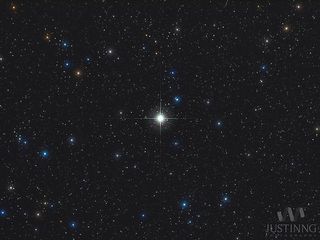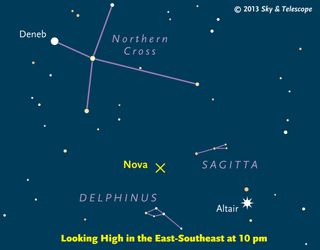Nova Star Explosion Is Visible to the Naked Eye: Where to Look

A dazzling star explosion discovered in the night sky last week is the brightest nova seen from Earth in at least five years and it's visible now to the naked eye.
The Nova Delphinus 2013 star explosion can be seen by the naked eye from places without too much light pollution, skywatching experts say. The stellar phenomenon is expected to be visible for weeks to come, and its location in the night sky should make the nova easy for even novice stargazers to spot.
"The nova is easy to locate north of the lovely star pattern of Delphinus. And the constellation Sagitta, the Arrow, points right toward it," Tony Flanders, associate editor of Sky & Telescope, said in a statement. [See Stargazer Photos of Nova Delphinus 2013 (Gallery)]
Arne Henden, who is director of the American Association of Variable Star Observers (AAVSO), added that the nova will be easily visible in the eastern sky starting in the early evening.
"The nova can be seen with binoculars even from light-polluted metropolitan areas," Henden said in a statement. "Hundreds of observers, many for the first time, have submitted brightness estimates of the nova to the AAVSO."

In the last 112 years, 47 novas have brightened into naked-eye view and novas as bright as Nova Delphinus 2013 occur about every 10 years, skywatching experts say. The new nova has also been referred to as Nova Delphini 2013.
Nova Delphinus 2013 was discovered by Koichi Itagaki of Yamagata, Japan, in an image taken on Aug. 14. Itagaki noticed a bright spot that was not present in a photo of the sky that he took the previous day.
Get the Space.com Newsletter
Breaking space news, the latest updates on rocket launches, skywatching events and more!
Before erupting, the nova was apparently a dull magnitude +17 star on the scale used by astronomers to measure the brightness of night sky objects, in which higher numbers denote dimmer objects. The threshold of what the human eye can see is about magnitude +6.5.
But Nova Delphinus 2013 increased in brightness by about 100,000 times when it reached a peak magnitude 4.5 on Aug. 16. Now the nova is holding steady at magnitude 4.9, but its intensity could change.
"It could remain at this brightness for many more days, it could re-brighten, or it could fade rapidly," Henden explained.
A typical nova occurs in a binary system where one at least one star is a white dwarf, a tiny, super-dense core of a star. Its companion star sends a stream of hydrogen onto the white dwarf and when that gaseous layer grows thick and dense enough, a runaway hydrogen-fusion reaction is set off.
Unlike in supernovas, white dwarfs survive novas, and the process may repeat in a few years to tens of thousands of years.
Editor's Note: If you snap an amazing picture of the new nova star explosion, or any other night sky view that you'd like to share for a possible story or image gallery, send photos, comments and your name and location to managing editor Tariq Malik at spacephotos@space.com.
Follow Megan Gannon on Twitter and Google+. Follow us @SPACEdotcom, Facebook or Google+. Originally published on SPACE.com.
Join our Space Forums to keep talking space on the latest missions, night sky and more! And if you have a news tip, correction or comment, let us know at: community@space.com.

Megan has been writing for Live Science and Space.com since 2012. Her interests range from archaeology to space exploration, and she has a bachelor's degree in English and art history from New York University. Megan spent two years as a reporter on the national desk at NewsCore. She has watched dinosaur auctions, witnessed rocket launches, licked ancient pottery sherds in Cyprus and flown in zero gravity on a Zero Gravity Corp. to follow students sparking weightless fires for science. Follow her on Twitter for her latest project.
Most Popular


